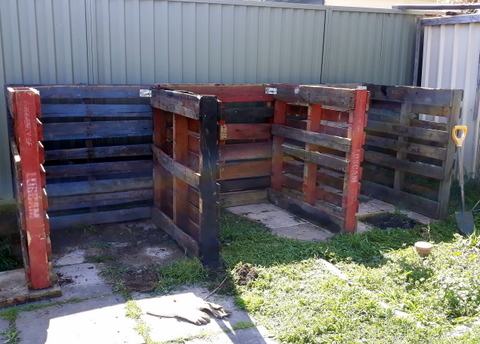
Over the years I have tried many composting systems (previous thoughts can be read here) but for one reason or another, none really worked out for me. I had, of course, considered the classic of composting – The three bay compost system. This works by placing a mix of organic matter into one of the bays, letting it heat up and cool down, then turning it into the next bay along (then refilling the first bay with new stuff), allowing the material in the second bay to heat up and cool down, then turning the finished compost into the third bay, where it is ready for use. The process then continues.
I have always found it interesting that in the books, the way it is described that the material in one bay is turned into the other is that it should be done in such a way that the material on the outside of the pile, is placed on the inside of the pile. Makes may wonder if the people advocating it had actually tried to do it!
Anyway, I always seemed to find reasons for not giving it a go. Things like –
- We don’t produce enough organic matter to make it feasible,
- We don’t have enough room,
- It will look messy and crappy (to be fair this was Linda rather than me!)
Our council provides us with a green bin so for the most part our FOGO waste want in there, after removing some small amounts for the chooks and the worms, and grass clippings often being used as mulch.
It has taken a while but I have been noting lately that the green bin is quite often going out full. Trash from the banana circle including banana ‘trees’ that have produced and passed on, choko trimmings and all of it once it has died back over winter, mulberry trimmings and corn stalks (which could be shredded) as well as some grass clippings, prunings and other miscellaneous vegetable matter. Over time it all adds up and results in lots of full green bins which I could be composting myself and it seems that we do produce enough organic matter to run a three-bay system!
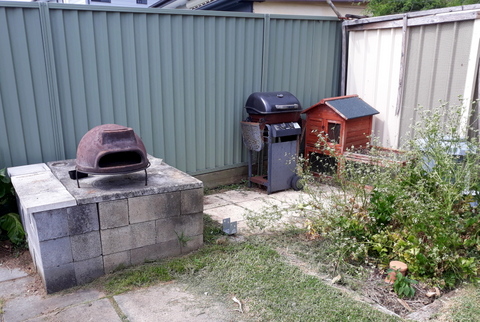
The area prior to cleaning and demolition
So the question was – where? We only have a 600m2 block and a lot of it is taken up with trees, water tanks, house and sheds, veggie beds, green house and so on. I had a place earmarked for other things against the northern fence, but after much consideration I decided that it would become the compost area after some demolition. I spent a couple of months clearing the area in preparation and conducting said demolition. With the area cleared, it just remained to obtain some pallets (my choice of construction material for the bays) and put them together.
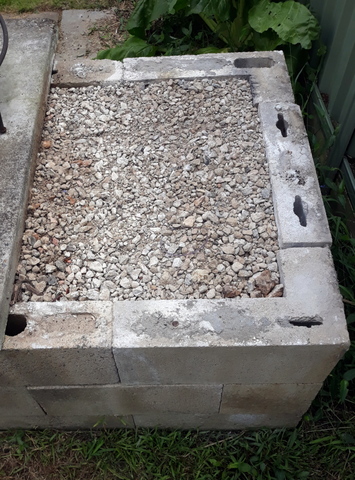
Oh no! It's full of crap!!!
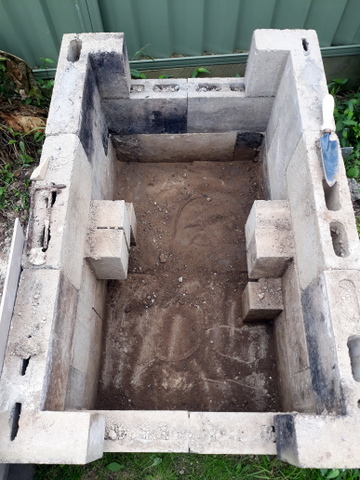
Empty and ready for demo!
In general terms pallets are constructed of softwood or hardwood. Softwood pallets tend to be lighter (and therefore easier to work with) and quite often available free, but rot more quickly and need replacement more often. In contrast, the hardwood pallets are quite a bit heavier, can be more difficult to come by/expensive, but last considerably longer. My dilly dallying about getting hold of the pallets was sorted out by the kids, and a nice load of hardwood pallets arrived in time for Father’s Day (2023).
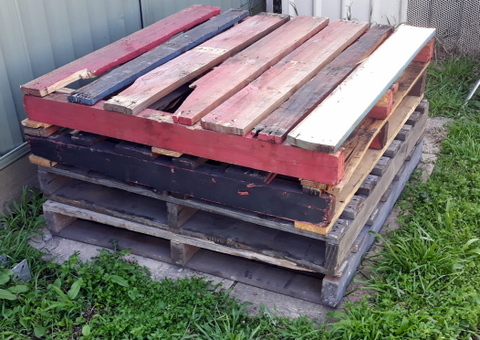
Raw materials arrive
Deniz came to give me a hand putting it up. First we stood the pallets up to work out the best configuration, which turned out to be run a continuous wall of pallets along the back and then attach the side pallets to that. We then moved the pallets away to dig out a bit of dirt so that the pallets along the back were straight and level. With the pallets along the back in place and steadied, we put the first side pallet in place and screwed in a couple of brackets to hold it, then did the same with the next side pallet and so on until all four were secured in place with two brackets per pallet, per side.
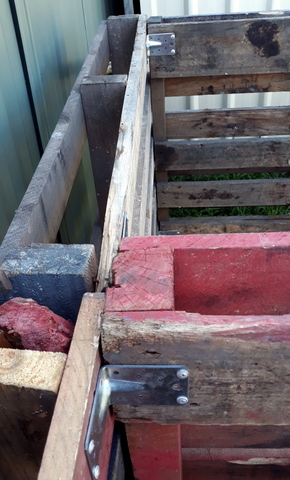
Looking along the back
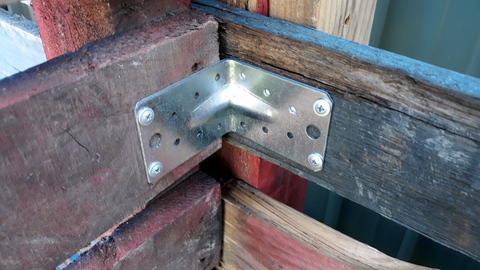
Bracket close-up
A part of the area where we were installing the compost bins was covered by pavers, which helped to keep the pallets level so I didn’t remove them entirely, but I did remove some from the middle of the bays to allow the compost contact with the soil, so that the soil biota could help with breaking the organic matter down and forming compost.
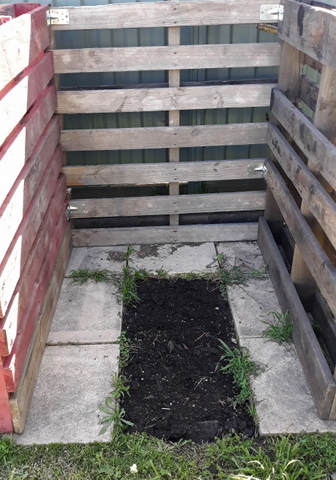
Pavers removed
It is semi-finished, because I do want to set up and install some slats on the front of the compost bins to stop material from spilling out the front, as a friend of mine has done (see pic below). He also harvests material from his constructed wetland to be added to the compost pile, which would otherwise go off site to be composted, which I hadn’t thought to do.
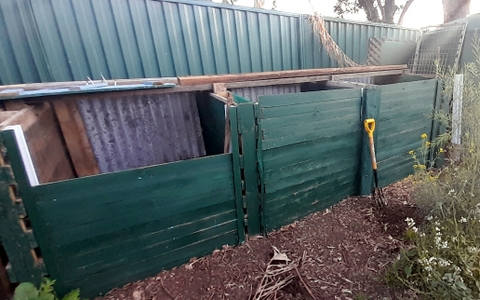
Amazingly enough, though Linda was concerned that the compost bins might look scrappy, even she was pleased with the compost bin visuals and noted that they tidied up what had been a messy area previously.
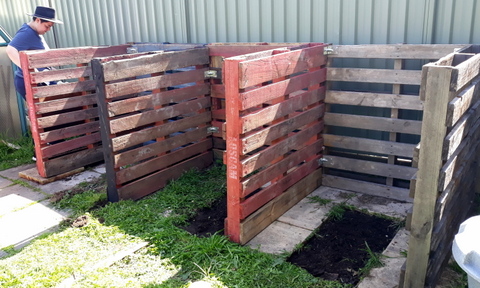
It is surprising that once the compost system is there, you start to see things that can go into it straight away, and what was a waste material before has become a resource. I have been packing in dead choko vine, banana trash, grass clippings and peelings etc. I was even able to make use of an unwanted area out the front of a neighbour that was producing a very nice white clover crop by mowing, then incorporating the clippings into the compost,
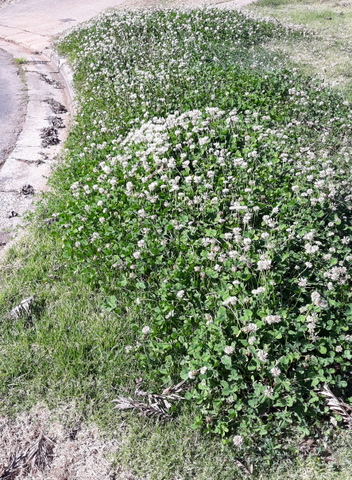
A lovely (if unwanted) stand of white clover, now harvested and in the compost bay
Another happy thing that I wish I could say I planned but was sheer coincidence, was that because of the compost bays’ closeness to the greenhouse, materials like dead plants, excess filled newspaper pots and leftover seed raising mix from punnets, can now directly into the compost instead of a heap outside the greenhouse door.
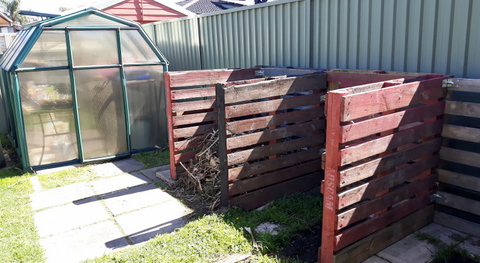
So, now I look around with a new eye for compostable material, Linda is happy because the area looks better and I am pleased because material which used to go offsite (albeit to commercial composting) is now retained here and the fertility it generates will help us grow better veggies. Everyone is a winner! (except maybe the council, who gets less in their green bin, although I could not bring myself to add used cat litter to ours so the council still gets that!)



